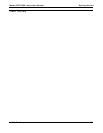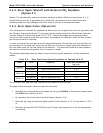
Model GFC7000E Instruction Manual Optional Hardware and Software
04584 Rev A1 40
5.4.2. Zero/Span/Shutoff with External CO
2
Scrubber
(Option 51)
Option 51 is operationally and pneumatically identical to Option 50 above (see section 5.4.1),
except that the zero air is generated by an externally mounted zero air scrubber filled with
indicating soda-lime that changes color from white to pink as it becomes saturated.
5.4.3. Zero/Span Valve (Option 52)
This valve option is intended for applications where zero air is supplied by a zero air generator like
the Teledyne Instruments Model 701 and span gas are being supplied by Gas Dilution Calibrator
Like the Teledyne Instruments Model 700 or 702. Internal zero/span and sample/cal valves
control the flow of gas through the instrument, but because the calibrator limits the flow of span
gas no shutoff valve is required.
In order to ensure that span gas does not migrate backwards through the vent line and alter the
concentration of the span gas, a gas line not less than 2 meters in length should be attached to
the vent span outlet on the rear panel of the analyzer. To prevent the buildup of back pressure,
this vent line should not be greater than 10 meters in length.
The following table describes the state of each valve during the analyzer’s various operational
modes.
Table 5-2: Zero/Span Valve Operating States for Options 52 & 53
Mode Valve Condition Valve Port Connection
(Fig. 5-2)
Sample/Cal Open to SAMPLE inlet 3 Æ 2
SAMPLE
(Normal State)
Zero/Span Open to ZERO AIR inlet 3 Æ 2
Sample/Cal Open to zero/span inlet 1 Æ 2
ZERO CAL
Zero/Span Open to ZERO AIR inlet 3 Æ 2
Sample/Cal Open to ZERO/SPAN inlet 1 Æ 2
SPAN CAL
Zero/Span Open to SPAN GAS inlet 1 Æ 2
The minimum span gas flow rate required for this option is 800 cm
3
/min.
The state of the zero/span valves can also be controlled:
• Manually from the analyzer’s front panel by using the SIGNAL I/O controls located under
the DIAG Menu (Section 6.9.2),
• By activating the instrument’s AutoCal feature (Section 7.6),
• Remotely by using the external digital control inputs (Section 6.13.1.2 and Section 7.5.2),
or
• Remotely through the RS-232/485 serial I/O ports (see Appendix A-6 for the appropriate
commands).


















